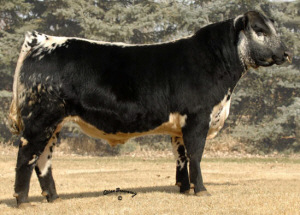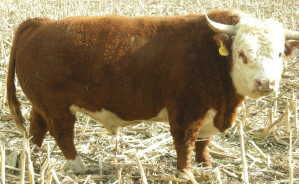



Highland
History
Like their name suggests, Highland cattle originated in the Highlands and west coastal islands of Scotland, areas severe in climate and lashed by the North Atlantic gales. Throughout the long recorded history of Highlands, breeders have taken great care to retain the original characteristics of these cattle. Originally, the breed was divided into two classes, the West Highlands or Kyloe, and the Highlander.
The Kyloes, raised on the western islands of Scotland, tended to be of a smaller size and had a higher percentage of black and brindled cattle than the mainland Highlanders. The size difference was probably due more to the severe climate and limited rations that the island cattle were subjected to than to any genetic variation between the classes. Today all members of the breed are called Highland.
A little known fact about Highland breeders is that they don't call their herd a herd. It is called a fold of Highland cattle because, in the olden days in winter the cattle were brought together at night in open shelters made of stone called folds to protect them from the weather and wolves.
Characteristics
The Highland has the grandest head with a long fringe (that appears to cover the eyes) and the horns that are long and darken towards the tip, it is these features that make them most memorable.
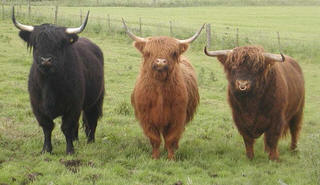 Photo courtesy of Craigowmill Fold, www.highlandcattle.co.uk |
The hair colour can be black, brindled, red, yellow, and dun - there is considerable difference of opinion among breeders as to which is preferable.
The breed is exceptionally hardy with a natural and unique ability to convert poor grazing efficiently. They are remarkable for their longevity, many Highland cows continue to breed to ages in excess of eighteen years having borne fifteen calves. The mothering instinct is highly developed in the Highland cow. Abandoned calves, for even first-calf heifers, are rare. This strong protective inclination of the cow minimizes predator losses that can even extend to sheep that are pastured in the same field. The Highland calf is exceptionally hardy and grows rapidly up to weaning.
Mature bulls can weigh around 1,800 pounds (800 kilograms) in breeding condition and cows 1,100 pounds (500 kilograms)
The Highland has a modern beef carcass with lean, well-marbled, flesh that ensures tenderness and succulence with a very distinctive flavour. Highland beef is healthy and nutritious with lower levels of fat and cholesterol and a higher protein and iron content than other beef.
The unique attributes of the pure Highland cow make her the first choice for the production of commercial hill cows. These can be sired by many different breeds of bull; a commonly used sire being a Beef Shorthorn bull, but recently excellent results have been obtained using continental sires.
The cross Highland cow the inherent hardiness of the pure Highlander, plus that vital ingredient "hybrid vigour". The cross Highlander has the milk to rear the continental calf with the high beefing potential demanded by today's market Both the pure Highlander and the first cross Highlander retain the prime ability to convert poor hill grazings into quality beef carcasses.
Statistics
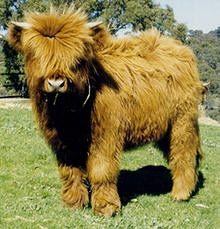 Photo courtesy of Duel M Highland Cattle, www.highlandcattle.com |
The Highland's proven ability to produce top quality meat without the addition of expensive high quality feeds makes this breed the perfect choice for those people who wish to produce beef with natural inputs.
Their horn's provide predator protection. Their long bangs (dossan) protect the eyes and face, shorter legs mean fewer foot and leg problems.
The natural free-ranging ability of Highlanders coupled with unassisted calvings in all conditions as well as a rich milk high in butter fat make the Highland cow an ideal mother.
Highland cattle are truly easy unassisted calvers, birth weights average 50-75 pounds. The calves moderate bone structure and slim conformation along with the cow's wide pelvic reduce calving problems such as caesarean and prolapse.
The Highland cow has a long productive life and many herds average 12 calves from each cow. This greatly reduces their replacement cost, a most important factor these days.
Cow's display high fertility and regularity of calving. Highland bull's are aggressive as herd sires.
Highland milk is high in butterfat, producing vigorous calves with acceptable natural weight gains. Cow's have superior udder quality an small teats.
Highland beef is slow-maturing making it a premium beef which is lean, well marbled with low fat and cholesterol levels whilst remaining rich in protein and flavour, criteria increasingly demanded by today's market.
Highland beef is able to command a premium over other breeds due to its all-round healthy eating appeal.
As the majority of the above traits are hereditory, Highland cattle are an ideal choice for inclusion in any cross breeding programme.
Comparative
Meat
A heavy coat insulates against a harsh climate and reduces the need to develop excess back fat. Recent studies in both North America and the UK have shown that Highland Beef is consistently much lower in fat content and cholesterol than other breeds. It is so lean that it compares with chicken and fish fat content.
The marbling of the beef gives the same tenderness and tastiness as the other larger breeds. Studies in the US have verified that Highland Beef is 38% lower in fat content and 4% lower in cholesterol than steaks from local supermarkets.
Studies in the UK list the quantities of fat per 100 grams as:
FAT CONTENT
Highland Beef Overall 4.5 g/ 100g
Other Breeds Beef Overall 15.6 g/ 100g
CHOLESTEROL CONTENT
Highland Beef Overall 40.9 mg/100g
Other Breeds Beef Overall 64.3 mg/100g
PROTEIN
Highland Beef Overall 20.7 g/100g
Other Breeds Beef Overall 18.6 g/100g
IRON
Highland Beef Overall 2.1 mg/100g
Other Breeds Beef Overall 2.0 mg/100g
Scottish Agricultural College, Dept. of Food Science and Technology published by McCance & Widdowson, Ministry of Agriculture, Fisheries and Food.
Distribution
The versatility of the Highlander led to a great upsurge in exports to the USA, Canada, Australia, New Zealand, Norway, Sweden, Denmark, Finland, Germany, Belgium, France, Switzerland, Luxembourg, Czech Republic, Poland, the Faroe Islands, Austria, Holland and South America. Highland Cattle can be found foraging 10,000 feet up in the Andes.
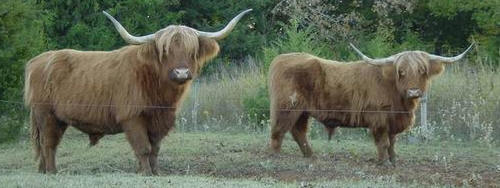
References (the above information was cited from the following sites)
www.highland-cattle.co.uk
www.highlandcattlesociety.com
www.chcs.ca
www.ontariohighlandcattle.com
www.heatheryford.com
www.highlandcattle.co.uk
www.highlandcattle.com

